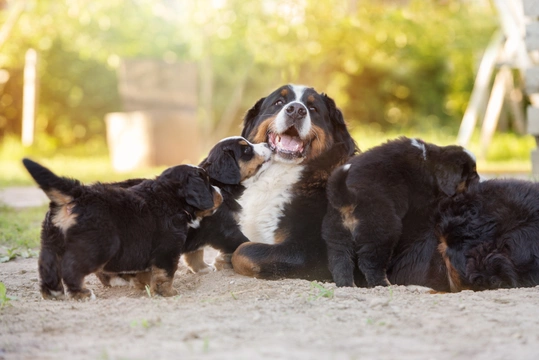
Breeder guidelines for dogs
If you're new to breeding, or even if you aren't, you might have some questions about how to breed safely without compromising the health of the mum or the pups. We've answered a few of the most common breeding questions to help you make safe decisions, plan ahead, and prioritise the welfare of your dogs and their litters.
How old should a dog be before having puppies?
A dog should be fully mature before being used for breeding. It has to be full-grown to be physically large enough to give birth. Not to mention that we can't expect a youngster to have a good mothering ability if she's not technically an adult herself. Therefore, it's best not to breed a dog until they’re at least two years old.
How long should you wait in between litters?
The Kennel Club, where pedigree dogs are registered, does not allow breeders to register more than one litter per dog per year. And this is for a good reason because a dog's body needs time to recover from pregnancy, labour, and feeding puppies. Therefore, a gap of at least one year is recommended.
How many litters is a healthy amount over a dog’s lifetime?
Female dogs shouldn't be bred earlier than two years old or older than seven. This is the optimum age range and reduces the risk of complications that could affect the mum or the pups. Therefore, using this age range and the recommended interval between litters, the maximum number of litters a dog should have in their lifetime is four.
What signs should you look for that your dog shouldn't get pregnant again?
-
Labour complications
Suppose your dog struggled to give birth last time, requiring a caesarean section or other significant veterinary intervention. In that case, breeding them again might not be a good idea. A caesarean section can lead to internal scarring that may make it harder for the dog to get pregnant or give birth next time.
-
Not enough milk
If the puppies had to be hand-reared or supplemented with puppy milk because their mother wasn't producing enough milk, it might not be a good idea to breed from her again. As well as being a commitment, hand-reared puppies are more likely to get infections because they don't get the immunity they need from their mother's milk.
-
Puppy rejection
If the mother rejected their previous litter, this could be a sign not to continue to breed them. They may be stressed, have low milk production, or be poorly suited to motherhood.
-
Stress
If you noticed that your dog was very anxious after having a litter, perhaps going off her food, panting a lot, becoming unusually aggressive, or rejecting the pups, you should consider whether you let her have another litter.
-
Veterinary advice
Suppose a vet has told you that it's not a good idea to breed a dog, either because they are passing on genetic diseases or anatomical traits that risk the health of their puppies or the breed as a whole. In that case, you shouldn’t continue to breed them.
Conclusion
Breeding dogs comes with a huge responsibility. But as long as you do your homework and prioritise the health and welfare of your dogs, you can enjoy following your puppies' entry into the world and their journey through life.
Dr Hannah Godfrey BVetMed MRCVS



